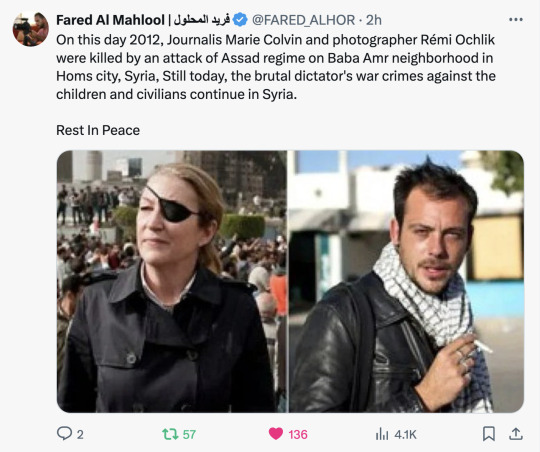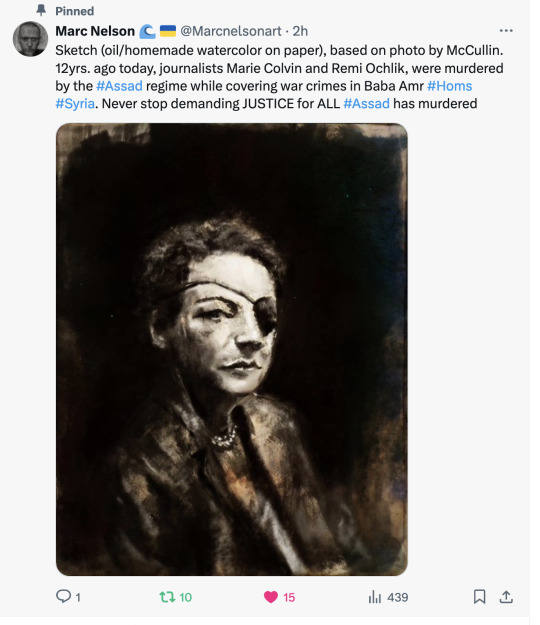#Marie Colvin
Text


THEM.
#my thespians#WOMEN#<3#Sophie Okonedo#Ratched#Charlotte Wells#Ondine Duquette#Rosamund Pike#A Private War#Marie Colvin#Gillian Anderson#The Crown#Margaret Thatcher#Mrs. T#Sarah Paulson#Impeachment#American Crime Story#Linda Tripp#tweet from: @evilrelaysp0rt
148 notes
·
View notes
Text
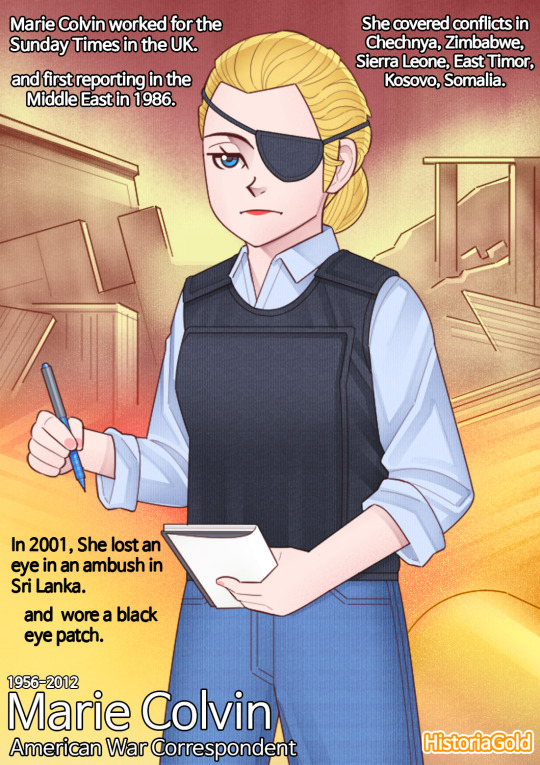
[History of USA] Marie Colvin
2 notes
·
View notes
Text
educate yourself ~ with Marie Colvin a woman we should know
Veteran Sunday Times war correspondent, Marie Colvin was killed in February 2012 when covering the uprising in Syria.
On the Front Line is an Orwell Special Prize winning journalism collection from veteran war correspondent Marie Colvin, who is the subject of the movie A Private War, starring Rosamund Pike and Jamie Dornan.
Marie Colvin held a profound belief in the pursuit of truth, and the…

View On WordPress
0 notes
Text

24 years ago today an all-star tribute to Joni Mitchell was held at the Hammerstein Ballroom in New York City featuring performances by Elton John, Bryan Adams, Shawn Colvin, James Taylor, Cyndi Lauper, Richard Thompson, k.d. Lang, and Mary Chapin Carpenter.
youtube
#listen to music#joni mitchell#tribute concert#live music#all-star tribute#hammerstein ballroom#new york#elton john#bryan adams#james taylor#cindy lauper#k.d. lang#mary chapin carpenter#richard thompson#shawn colvin#Youtube
7 notes
·
View notes
Photo

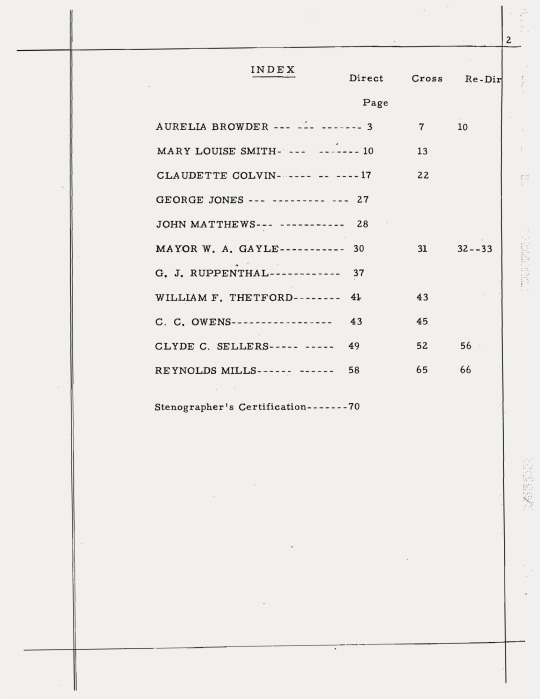
Testimony from Aurelia S. Browder et al. v. W. A. Gayle, et al., No 1147, District Court of the United States for the Middle District of Alabama, Northern Division, May 11, 1956 (pdf here) [Civil Case Files, 1938-1995, Records of the District Courts of the United States, Civil Rights Digital Library, Digital Library of Georgia, GALILEO, University of Georgia Libraries, Athens, GA]
#civil court records#aurelia browder#mary louise smith#claudette colvin#susie mcdonald#district court of the united states#middle district of alabama#civil rights digital library#digital library of georgia#university of georgia libraries#1950s
11 notes
·
View notes
Text
Not me googling "rosamund pike eye patch"
#l m f a o#MARIE COLVIN ARE YOU SHITTING MY DICK??????? thats so fucking badass#like????????????#not what i expected#rosamund pike#💖ros💖
2 notes
·
View notes
Text
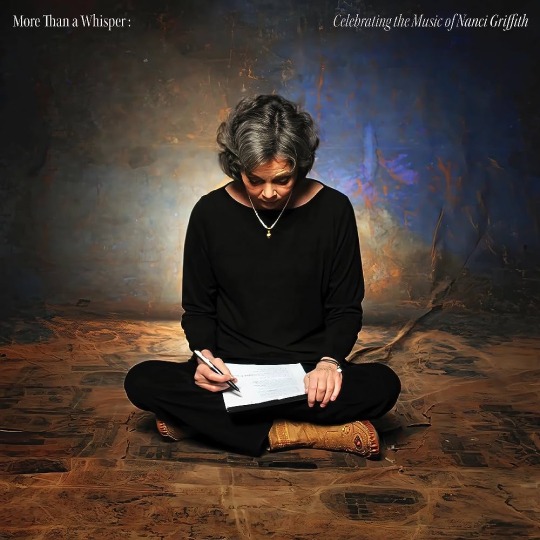
Album Review: Various Artists - More than a Whisper: Celebrating the Music of Nanci Griffith
Though she does not sing on More than a Whisper, Nanci Griffith’s voice can be heard across the 14 songs that make up the various-artists’ tribute to the late singer-songwriter, who died in 2021.
Subtitled Celebrating the Music of Nanci Griffith, Whisper does exactly that, opening with Sarah Jarosz’s version of “You Can’t Go Home Again” and closing an hour later with the War and Treaty’s rendition of “From a Distance.”
In between these cuts, the artists, going all the way back to Emmylou Harris on “Love Wore a Halo (Back Before the War)” and coming all the way up to Billy Strings and Molly Tuttle doing “Listen to the Radio,” are careful to follow the contours of Griffith’s compositions. And while they all bring their own, distinct voices and instrumental capabilities to the studio, they all also leave room for listeners to hear Griffith’s own voice echoing through time, resulting in the rare such compilation that hangs together despite its disparate contributors.
Among the highlights are John Prine and Kelsey Waldon’s “Love at the Five & Dime,” Steve Earle’s “It’s a Hard Life Wherever You Go,” Todd Snider’s “Ford Econoline” and Iris DeMent’s “Banks of the Pontchartrain.” Lyle Lovett and Kathy Mattea, Brandy Clark, Shawn Colvin, Ida Mae, Aaron Lee Tasjan and Mary Gauthier also appear.
Grade card: Various Artists - More than a Whisper: Celebrating the Music of Nanci Griffith - B
10/25/23
#nanci griffith#more than a whisper: celebrating the music of nanci griffith#2023 albums#sarah jarosz#i’m with her#the war and treaty#emmylou harris#billy strings#molly tuttle#john prine#kelsey waldon#steve earle#todd snider#iris dement#lyle lovett#kathy mattea#brandy clark#shawn colvin#ida mae#mary gauthier#aaron lee tasjan
0 notes
Text
War reporting always carries risk. The Committee to Protect Journalists has documented the deaths of media workers in the conflicts in Ukraine and Syria. Middle East conflicts have always been dangerous places for journalists; it’s hard to ignore high-profile deaths of journalists like Marie Colvin of London’s Sunday Times in Syria, or freelance photographers Chris Hondros and Tim Hetherington in Libya. In that sense, the war in Gaza and a possible war in southern Lebanon are no exceptions.
But as FAIR documented during the previous Israeli military operation against Gaza, Israel has a long history of targeting Palestinian journalists, as well as harassing foreign journalists and human rights activists entering the country. Over the summer, the International Federation of Journalists reported that “several journalists have been directly targeted by Israeli snipers as they were reporting on Israel’s large-scale military operation in Jenin.”
Inside Israel, the situation for journalists is relatively safer, but the far-right government has—like authoritarian governments in Poland and Hungary—attacked journalists and the ability to critically cover institutions in power. Prime Minister Benjamin Netanyahu in 2019 accused the owners of Israel’s Channel 12 of committing a “terror attack against democracy” for reporting on the corruption charges against him.
In 2020, Netanyahu indicated that “Channel 13 journalist Raviv Drucker should be arrested and jailed” for airing “recordings of Netanyahu crony Shaul Elovich and his wife, which demonstrated how they sought to tilt news coverage in the prime minister’s favor.”
Galit Distel-Atbaryan, who recently resigned from her role as public diplomacy minister, reportedly said this summer that she wanted the “authority to deny press credentials to foreign journalists critical of Israel”.
75 notes
·
View notes
Text

Rosamund Pike attends the 76th Annual Golden Globe Awards on January 6, 2019 in Beverly Hills, California.
She was nominated for Best Actress in a Motion Picture - Drama for her role as Marie Colvin in ‘A Private War’.
Ph. Kevork Djansezian
20 notes
·
View notes
Text
MOGAI BHM- Day 6!
happy BHM! today i’m going to be talking about Claudette Colvin, Mary Louise Smith, and Rosa Parks, as well as the Montgomery Bus Boycott!
Claudette Colvin-

[Image ID: A black-and-white photograph of the upper half of the body of Claudette Colvin, who, at the time of the picture, was a 15 year-old Black girl with short curled hair, speckled glasses, and a smile on her face. End ID.]
Textbooks across America tell stories of Rosa Parks- as they should. They, however, fail to mention the activists who did what she did before she did it. Claudette Colvin is one of these activists suppressed by white-dominated education systems.
Claudette Colvin was just 15 years old when, on March 2, 1955, her class at her segregated school was fervently discussing civil rights and the many ways the students had faced their rights being violated. Later that day, she was riding the bus home from school. The bus driver demanded that she get up and move to the back of the bus- but Claudette refused. She told the driver that it was her constitutional right to sit where she was sitting, which led to the driver calling the police, who grabbed her and arrested her. She later recalled the event saying "All I remember is that I was not going to walk off the bus voluntarily."
“I could not move, because history had me glued to the seat. . . It felt like Sojourner Truth’s hands were pushing me down on one shoulder and Harriet Tubman’s hands were pushing me down on another shoulder, and I could not move.”- Claudette Colvin.
Claudette was also not the first person to challenge bus segregation in this way, but her challenge was an influential event nonetheless and a predecessor to the famous and successful Montgomery Bus Boycott. A year later, Claudette would become one of the plaintiffs in a landmark civil rights case, and as a member of the NAACP Youth Council, her actions inspired fellow NAACP member Rosa Parks.
Mary Louise Smith-

[Image ID: A somewhat-grainy, black-and-white photograph of the face of Mary Louise Smith, a Black woman with medium length hair. She has a slight smile on her face and is resting her face in her right palm. End ID.]
Mary Louise Smith, like Claudette Colvin, was interested in activism and civil rights from an early age. On October 21, 1955, just 5 months after Claudette’s arrest, Mary, at the young age of 18, was told to give up her seat on a bus for a white person, and when she refused, she was arrested for defying segregation laws and fined.
This incident was kept pretty quiet. Mary, like Claudette, was considered and rejected to be the spokesperson/center of a planned lawsuit against segregation in bus systems across Alabama, so her bravery was not well-known.
Mary Louise Smith was also part of a lawsuit that challenged segregation in the Montgomery YMCA, and she was a fervent civil rights defender.
Rosa Parks and the Montgomery Bus Boycott-

[Image ID: A black-and-white photograph of a crowd of Black people walking on a sidewalk lined with trees and parked cars. End ID.]
In 1946, a group called the Women’s Political Council, a group of female Black professionals, formed. One of their focuses was challenging Jim Crow segregation laws. In 1954, the WPC tried, albeit unsuccessfully, to challenge segregation on Montgomery buses by holding a meeting with Montgomery’s Mayor W. A. Gayle. Jo Ann Robinson, the WPC’s president, further urged Gayle to comply with their list of demands for bus desegregation, and warned him that boycotts were being planned.
On December 1, 1955, Rosa Parks, like Claudette Colvin and Mary Louise Smith before her, refused to give up her seat on a Montgomery bus to a white woman. This led to her arrest, which led to the rapid growth of a new movement- the Montgomery Bus Boycott.
The day after Rosa’s arrest, Jo Ann Robinson with the help of the WPC and many other local Black community leaders, began to create pamphlets calling for a protest of bus segregation. As word spread about the protest, more and more people became involved. On December 5, 1955, 90% of Montgomery’s Black population boycotted using the buses. That afternoon, the Montgomery Improvement Association, or the MIA, was founded during a meeting to coordinate and extend the bus boycott into a long-term campaign, and Dr. Martin Luther King, Jr. was elected president of the association.
On 8 December, the MIA issued a formal list of their demands: courteous treatment by bus operators; first-come, first-served seating for all, with blacks seating from the rear and whites from the front; and black bus operators on predominately black routes. The demands were not met, which led to the extension of the Montgomery Bus Boycott through the next year.
Montgomery city officials tried to quash the Montgomery Bus Boycott by punishing Black taxi drivers who helped Black citizens avoid using the buses- but in response to this, the MIA organized complex networks of taxi carpools to help Black citizens avoid the buses. After King’s home was bombed and he was indicted and charged for his involvement in the boycott, many feared the movement would end, but it kept going strong.
The Montgomery Bus Boycott began to make national news, which resulted in many people and outside organizations coming to lend support. More civil rights activists engaged in nonviolence training programs, founded organizations to raise funds for activists in the South, and partnered with King and the MIA to continue the movement.
Finally, on June 5, 1956, two of the predecessors of Rosa Parks’s act of defiance, Claudette Colvin and Mary Louise Smith, joined Aurelia S. Browder and Susie McDonald as plaintiffs in the case that ended bus segregation in Alabama. These four Black women had a case filed for them against public bus segregation, and on June 5, 1956, the federal district court ruled in Browder v. Gayle that public bus segregation was unconstitutional and illegal. The Montgomery Bus Boycott; however, continued for months beyond this until the federal circuit court actually enforced their ruling, especially in Montgomery. On November 13, 1956, they struck down public bus segregation laws, and on December 17, 1956, they rejected appeals to challenge Browder v. Gayle, and three days later, the bus desegregation order reached and was enforced in Montgomery. Thus marked the end of the Montgomery Bus Boycott.
Sources-
https://www.npr.org/2009/03/15/101719889/before-rosa-parks-there-was-claudette-colvin
https://www.zinnedproject.org/news/tdih/claudette-colvin/
https://theforgivenessfoundation.org/2021/08/07/black-history-month-mary-louise-smith-remembering-the-women-who-came-before-rosa-parks/
https://kinginstitute.stanford.edu/encyclopedia/montgomery-bus-boycott
https://kinginstitute.stanford.edu/encyclopedia/browder-v-gayle-352-us-903
71 notes
·
View notes
Text
The Queen's speech at the Foreign Press Association Awards 2023
Ladies and gentlemen, it is a huge pleasure to be here with you this evening to celebrate the 135th anniversary of the Foreign Press Association and to reflect on your many achievements as the world’s oldest and biggest association of foreign journalists. But I cannot begin without also reflecting that as we gather, journalists, photographers and their support teams are even now risking their lives. We think particularly of those reporting from Ukraine and the Middle East in these most difficult of times.
By joining you this evening, I am following in the footsteps of my husband, an honorary member of the FPA, who joined you at these Awards in 2008. On that occasion, he described your role as “not only to look at the world and study the way it works, but to report what you see accurately, to explain it and indeed to interpret it. In so doing you shape the view and define the perspective of millions of people and that is an enormous responsibility”.
I know, second-hand, a little of the responsibility of your profession. There are journalists in my family…and I have even been the subject of one or two stories myself over the years... I have also had the opportunity to visit a significant number of newsrooms and have seen how tough your work is. Particularly, if I dare say so, for women, who, despite the many hurdles they have faced, have been among the bravest reporters of all. From trailblazers like Martha Gelhorn and Christiane Amanpour, to those such as Marie Colvin (an FPA Journalist of the Year) and Daphne Caruana Galizia, who have so tragically paid with their lives, their courage was matched only by their conviction that the truth matters. Perhaps this has never been more evident than in our digital age, where disinformation runs rife and where female journalists are increasingly targeted on social media. The FPA has done much to promote and protect women throughout your long history, appointing your first female President in 1955, and, more recently, providing specialised training for women to deal with disruptive and abusive behaviour from members of the public. For this, all your readers and broadcast audiences are in your debt.
As the late great Dame Ann Leslie wrote, it is among the sacred duties of journaliststo ‘face the glacier in the cupboard and to expose its coldness and cruelty to the bright, clear and humanising light of day.’ That is what she, and all of you, do. This is especially true in one area of your work for which I should particularly like to thank you: raising awareness of domestic and sexual abuse against women in every part of the globe. The FPA was, of course, founded in 1888, when foreign correspondents came to the United Kingdom to report on the Jack the Ripper murders and decided to band together to secure better access to information and sources. Although we might now deplore some of the more sensational approaches to those terrible events, the fact is that the FPA grew out of the need to reveal and condemn violence against women. And this remains a key part of journalism today. You have the ability to break the corrosive silence that frequently surrounds abuse. You bring into the open the voices of victims, you break taboos, you shine a light on these heinous crimes and you guide the public on what they can do to help. As the foreign correspondent Christina Lamb makes clear in her devastating book ‘Our Bodies, Their Battlefield’, rape and sexual abuse continue to be a pervasive and all-too-often hidden feature of conflict zones the world over.
Ladies and gentlemen, as my husband observed 15 years ago, yours is an awe-inspiring responsibility: you question, debate and analyse and thus protect what is so easy for us to take for granted – true freedom of expression. As I said at the London Press Club Awards in 2011, I believe freedom of expression to be at the heart of our democratic system. In this, you play a vital, if not pivotal role.
Take courage from the words of one of our greatest writers, and former journalist, Tom Stoppard: “I still believe that if your aim is to change the world, journalism is a more immediate short-term weapon”. May you continue to use it wisely. Thank you.
13 notes
·
View notes
Text
“Palestinian youths used stones and marbles, often in slingshots, to taunt young Israeli soldiers, who shot back with tear gas and live fire. The Palestinians always came off worse. Funerals would turn into protests and so it would roll on, violence ebbing and escalating, the world transfixed by the desperation of a Palestinian generation who saw no future.”
― Lindsey Hilsum, In Extremis: The Life of War Correspondent Marie Colvin
9 notes
·
View notes
Text
Here's my list of forgotten/cool women from history. Please take it, reblog it with more, spread it, learn about them, make books about them:
Lucy (slave used for experimentations on the uterus)
Nightwitches from WW2
Grace Hopper
Mary Anning
Maria Mitchell
Ada Lovelace
Kate Warne
Agnes Barre
Flora Tristan
Olympe de Gouges
Eleanor Roosevelt
Bessie Smith
Sylvia Plath
Sweet Tee
Lady D (the rapper)
The Sequence
Lady B
Rachel Carson
Baya
Tahireh
Lalla Fatma N'Soumer
Rosalind Franklin
Miriam Makeba
Alexandra David Néel
Suzanne Noël
Helena Rubinstein
Katherine Switzer
Jeanne Barret
Sophie Germain
Katherine Johnson
Margaret Hamilton
Hedy Lamarr
Betty Snyder Holberton
Kathleen McNulty Mauchly Antonelli
Marilyn Wescoff Meltzer
Frances Bilas Spence
Ruth Lichteman Teitelbaum og Jean Jennings Bartik
Valerie Thomas
Karen Sparck Jones
Dr Shirley Ann Jackson
Radia Perlman
Stacy Horn
Dr Betty Harris
Beulah Louise Henry
Elizabeth "Jake" Feinler
Empress Zenobia of the Palmyrene Empire
Surya Bonaly
Dolly Parton
Mary Wollstonecraft
Mary Shelley
Queen Nzinga of Ndongo Kingdom
Queen Yaa Asantewa Ashanti
Empress Candace of Ethiopia
Queen Sarraounia Mangou of Aznas Kingdom
Dona Beatriz
Mileva Marić
Matoaka
Janet Sobel
Claudette Colvin
Marsha P. Johnson
Marian Anderson
Madam CJ Walker
Frida Kahlo
Mirka Mora
Dahomey Amazons
The 40 Elephants
Diamond Alice
Maggie Bailey
Julie d'Aubigny
Bessie Coleman
Policarpa Salavarrieta
Annie Oakley
Anna Julia Cooper
Sojourner Truth
Ida B. Wells
Shirley Chisholm
Mary Church Terrell
Audre Lorde
Harriet Tubman
Maria W. Stewart
Angela Davis
Florynce Kennedy
Jocelyn Bell
Alice Ball
Lise Meitner
Chien Shiung Wu
Marie Tharp
Elizabeth Blackwell
Amanirenas
Wu Zetian
23 notes
·
View notes
Photo
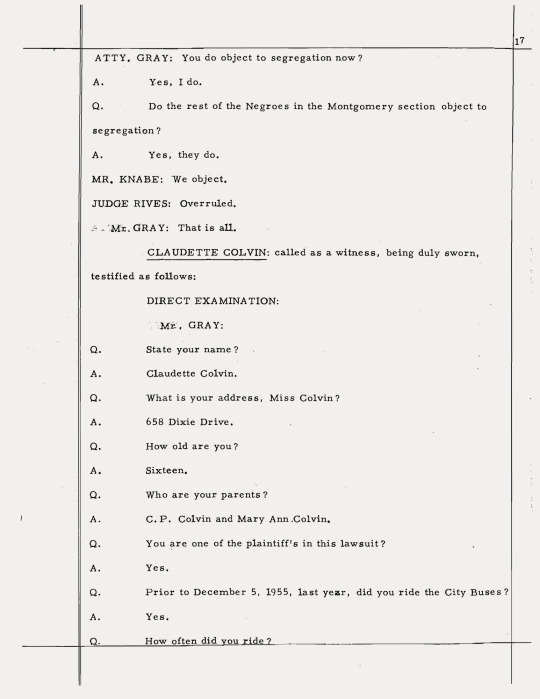
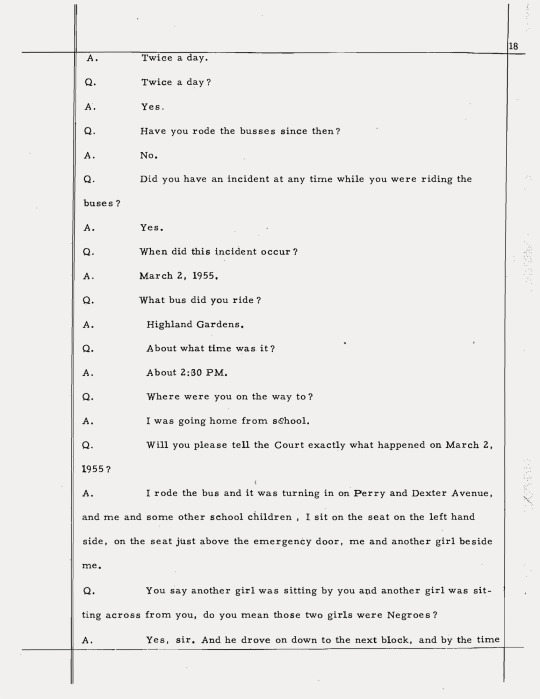
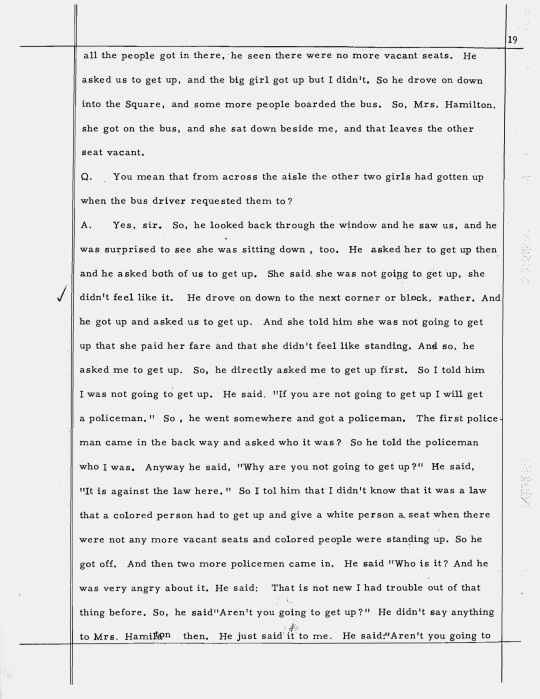


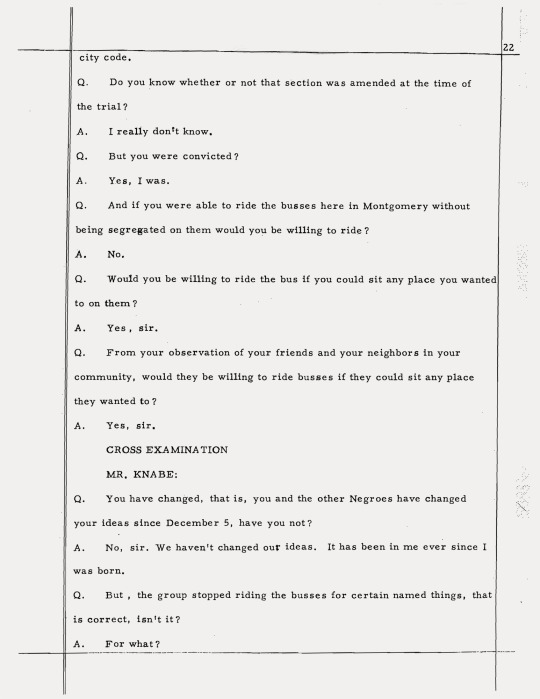
Claudette Colvin – Testimony from Aurelia S. Browder et al. v. W. A. Gayle, et al., No 1147, District Court of the United States for the Middle District of Alabama, Northern Division, May 11, 1956, pp. 17-22 (pdf here) [Civil Case Files, 1938-1995, Records of the District Courts of the United States, Civil Rights Digital Library, Digital Library of Georgia, GALILEO, University of Georgia Libraries, Athens, GA]
#civil court records#claudette colvin#aurelia browder#mary louise smith#susie mcdonald#district court of the united states#middle district of alabama#civil rights digital library#digital library of georgia#university of georgia libraries#1950s
9 notes
·
View notes
